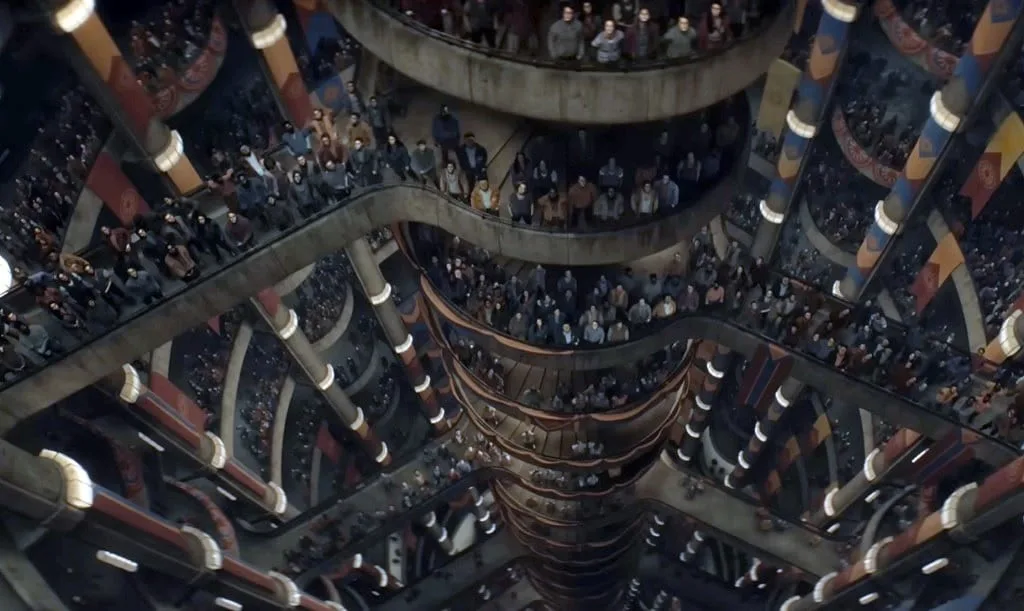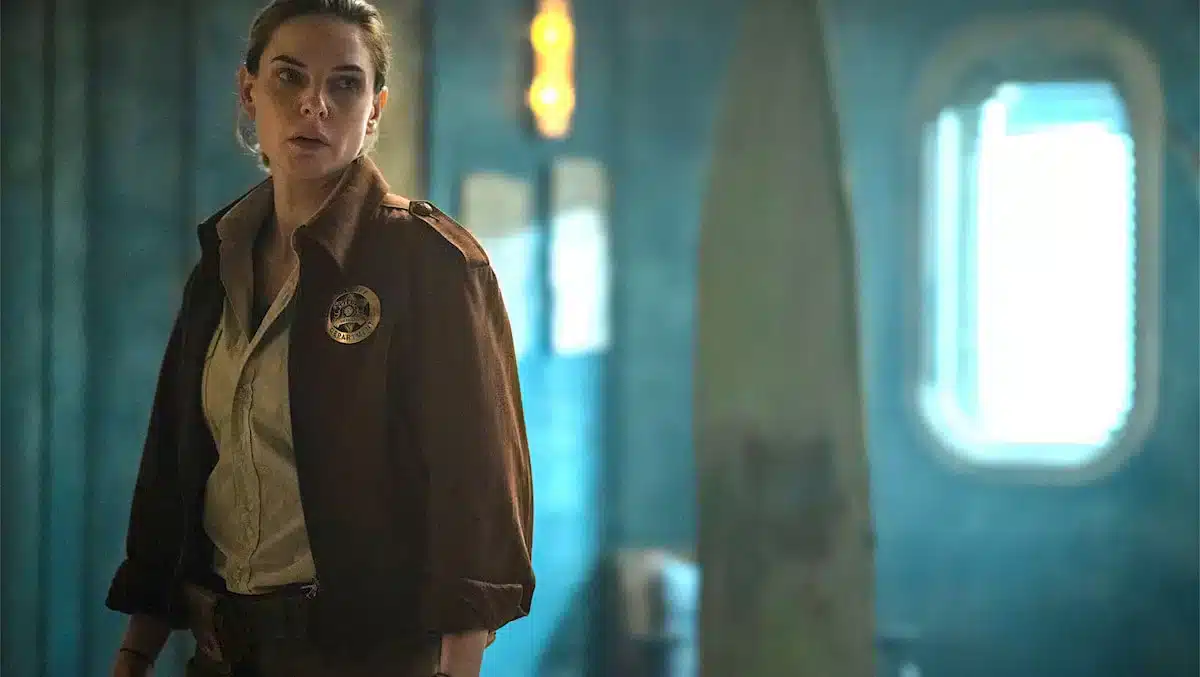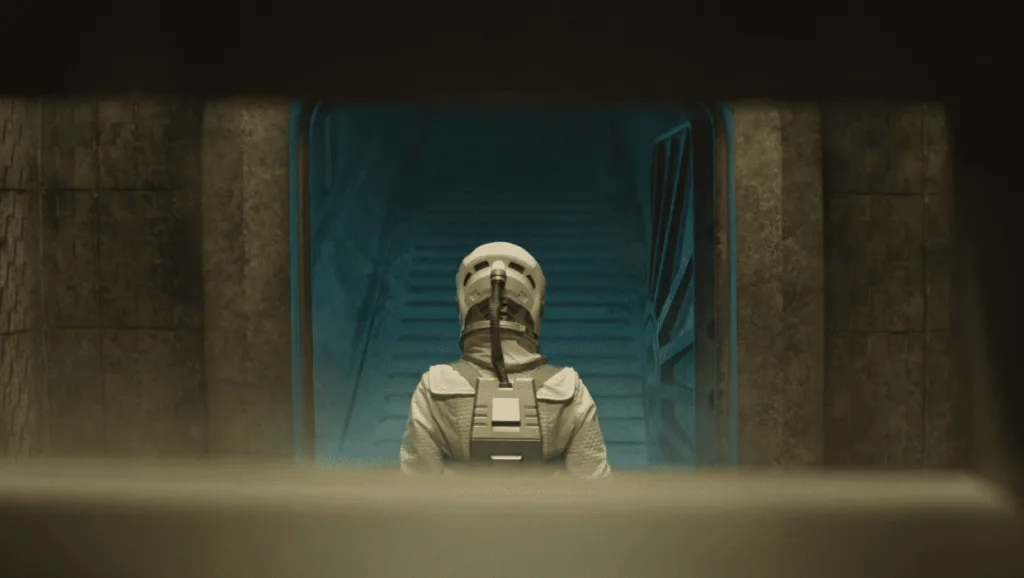
As dystopia has become established as a genre, it’s become the case that the futures it explores have wound up with a few similarities. There’s no mystique about this; dystopia amplifies and extends our fears about the world we currently live in, so environmental angst, fear of political corruption, conspiracy, loss of selfhood – all of these things, explored in different books, art and films, can take on something of a similar pall. But that is not necessarily a bad thing, and nor – with careful, patient, clever handling – need it mean meaninglessness. Silo (2023), based on a series of novellas by Hugh Howey, has many of these familiar elements. Aside from the stasis of its world, it could almost be Snowpiercer upended; the inhabitants of both these contained environments peer at the world outside in a similar way, and labour under class divisions and expectations that shape where they live and what they (can) do. But it’s by no means a simple re-tread of Snowpiercer, or anything else.
Rather than write a simple review of the series – and bearing in mind that this brilliant show has itself been siloed on Apple TV, which not everyone has or is likely to get on the strength of one recommendation – this article will focus on Silo‘s core elements and what makes it work so well. Then, it’s up to you. There are some discussions of elements of the show which could be classed as mild spoilers, though not going much beyond what’s contained in the Apple official trailer.
The closed environment…
In the series, what is left of humanity lives beneath the ground in the silo of the title; humanity, we are told, numbers around 10,000 people, whose lives are tightly controlled in order to avoid overwhelming the life support systems of the silo. For example, if you want to have a child, it needs the approval of the judiciary apparatus which exerts law and order; you get a narrow window of opportunity to conceive, and if you’re unlucky, then that’s it: you enter the lottery all over again, or – you don’t. The silo has features which are eminently recognisable; IT is a big industry, as computer systems are integral to the running of the silo on a functional level, as well as aiding communications between levels. Ah, the levels: the deeper you go into the silo – and we are led to believe that it is a journey of many hours and miles to amble all the way down the central staircase to the bottom levels – the closer to what we’d see as blue-collar, manual professions we get. The so called Deeper Downs help the silo to recycle, deal with its trash, run the vast central generator, and do all of the grunt work which is oddly despised by the very people who depend on it. This is the class system, measured by depth (which itself isn’t so unusual, given how mining and excavating propped up an industrialising First World for hundreds of years, and was seen/is seen in similar terms).

This closed environment also looks a little like the Vault-Tec system in the Fallout games – by which, we’re talking the post-2008 Fallout games, which have placed more and more emphasis on the vaults themselves. The presence of a canteen area, living quarters, communal areas; they all look recognisable, forming up that overlap again – this is, it seems, what we fantasise when contemplating abject destruction over the nearest hill. Some kind of Cold War folk memory, perhaps – this notion that a select few could hide away underneath the ground away from all that, and just wait it out – if they had the means to feed and water themselves, perhaps they could survive. Popular imagination has run with that idea, contemplating what a larger-scale survival could look like. It’s the same impetus which drives sci-fi explorations of space, with a different select group looking for sanctuary away from a by-now bruised, broken Earth. Those who remain need to dig in and fund a way to function; the silo offers a miniaturised society, heavily controlled with a hard-line system of government who wish to ‘keep the peace’ at all costs. This isn’t a bad call – a riot in such close quarters would be a dreadful thing, and potentially fatal – but you soon feel that this peacekeeping impulse is masking something else.
And life below…
The silo itself is somewhat claustrophobic, but not dreadfully so, which is quite something in itself. It’s a vast space, and Apple money has done it justice, making it look the part. Its inmates are reasonably well turned out – this ain’t The Salute of the Jugger – and its apartments have a kind of moribund Ikea model-apartment vibe to them, shabby but clean and comfortable, even if dark cracks show on the silo walls (hey, symbolism). There’s also a noticeable colour palette which extends down through all the levels and recurs in the inhabitants’ clothes – oatmeal, teal, grey, terracotta. Setting aside some quibbles as to how this silo can produce enough food for all these mouths, extensive hydroponics system or not (we only have quite so many humans walking around today because we have industrialised farming so extensively; anyone who has ever tried to grow their own food will have a fair notion of how much you have to do for how little, and by extension, how much farming it takes to keep us going), it’s a surprisingly functional, even bearable space. No wonder people are happy to play ‘better the devil you know’ here. And indeed, people are happy to do this now, here, in their millions. Clearly, whoever planned this place wanted to balance aesthetics, form, function and longevity, and it’s worked. We see people living contented lives. But how do the people living here rationalise their existence in this surprisingly functional space?

Unusually, the silo has almost no sense of a pre-silo past, or else it’s tenuous at best. The founders created a Code, which still exists and is used as a lawbook for all citizens – with some residents, such as Billings, incredibly well-versed in all of its edicts, knowing them off by heart. But unlike other dystopias, where there is usually at least some sense of the world which came before – even if gleaned – the silo’s sense of a past was fatally stymied (or so the powers-that-be insist) by a failed uprising, 140 years prior. So here’s another reason to keep law and order so strictly: previous insurrections cost the silo all sense of its purpose, leaving it with only fragments. But this level of concern extends to extreme caution about all evidence of a world prior, which negates the sense that losing that link with the past is regrettable. ‘Relics’ – items which date to before the uprising – are contraband, and possession of these relics, however recognisably unimportant they look to our eyes, mean severe punishments for the owners.
This means that simple items take on a strange significance; a Pez dispenser, shorn of its context, becomes a mysterious cypher, its purpose shrouded in mystery. It reminded me of post-apocalyptic novel Riddley Walker, another story where there’s little sense of a timeline from past to present; the novel’s inhabitants tear a rusted car from the earth, bewildered by its purpose but recognising the value of its iron; Riddley himself becomes fascinated with a puppet, actually a religious figurine used in puppet shows, but it takes on a strange degree of meaning for him. Good dystopia invites us to look again at familiar objects and, by seeing them as unfamiliar, understand something of a world beyond our current perception. We perhaps need to start small to really appreciate things on a larger scale. Silo makes an artform of this by rendering all pre-silo objects both compelling, and illegal and, if you’ve seen the uproar a Pez dispenser can cause, then brace for the impact of a more – shall we say – complex, revealing throwback to the Time Before.

In terms of the structure of the silo, and excepting that classism is literally built into its structure (whether that was ever the explicit aim or not), it’s also fascinating for what it has at the very top. There is a viewing window. Whilst convincing blue light filters into residents’ apartments through their blinds and curtains, making it almost seem that there is natural light throughout, the canteen – an area used by virtually everyone – displays a pertinent reminder of what people need to stay below ground. The world outside is drear, barren and hostile: to go outside is to ensure a quick, choking death. People must stay in the silo until it safe to leave (though how this would be clear, is less than clear). It’s a little like the dystopian version of the late medieval practice of displaying the heads of traitors – a warning and an exhortation to do better. And it does function in this way, besides being otherwise a fairly innocuous view; a twisted, dead tree draws the eye, looming ominously over an unseen ridge. But as well as a warning to the curious – one man begins to notice the strange ‘lights’ above the tree which move in patterns – the window is also the source of a simple, but effective punishment for transgressors (and for those who declare on their own terms that they no longer wish to live this way.)
“I want to go out!”
The Code is clear that, should anyone express a desire to leave the silo, then their request must be granted, but: once said, provided there are witnesses, that request can never be redacted. If someone wants to go outside, then ostensibly they are granted that freedom – but it’s a freedom with the very grand proviso that the world outside is so toxic, that it will likely kill them within minutes. The process of granting that request, too, has become ritualised, turned into a performance, with a script, for the other silo dwellers (who watch the progress of the quitter on the grand canteen display). The ritual is a blend of faux concern and draconian punishment; the only fate worse than going outside is hard labour in the mines beneath the silo (and there we go again, that association between hard manual labour and delinquency). But even then, in the mines, a person’s death agonies are not broadcast to the other residents of the silo. Step foot outside, and that’s exactly what happens, seemingly without fail.
We do, however, see people willingly leave the silo, equipped with a protective suit (definitely ritual dress, as it’s already renowned for being next to functionally useless) and a special cleaning cloth (which is why the first story in Howey’s series is titled ‘Wool’). The last request asked of the person leaving the silo is that they spend a moment to clean the window to the outside world, making it as clear as possible for those who remain that the world outside is dangerous; indeed, people keel over within view of the window, and their remains stay visible for years afterwards; the silo wants them as visible as possible, as well as having the window itself clean. When someone requests to leave, it’s known colloquially as ‘being sent to clean’ for this reason. And, perhaps surprisingly, people do seem to oblige: the reasons for this forms up one of the most engaging about-face plot points I’ve seen in a long time, after keeping the audience on a par with key protagonist Juliette throughout, wondering alongside her what is going on with this: what is out there? Is this some last moment of altruism by the person who’s gone outside, or is it something different? It fascinates the audience just as it fascinates some of those living underground, because we are never omniscient in this story. Our questions are their questions, and nothing fascinates human beings like the details of an ominous fate.

Why, though, would someone ask to go outside at all? In the series, it boils down to those who develop serious doubts about this narrative which has been presented to them over a series of generations. If they begin to think, seriously, that the world outside is not poisonous, and that saying it over and over forms part of a conspiracy by the rulers of the silo to maintain order (and control), then they may be enticed to try it for themselves. The mystery of the outside world frames the series, opening it, establishing the parameters of the mystery, and then inviting us to work it out. We see law-abiding – and law enforcing – individuals gradually become convinced of some different version of events, but they are seemingly silenced as soon as they leave. If this is another aspect of a plot, then there’s an additional question: whom does this benefit? Is it just about fear, or something else? Bluffs and double bluffs obscure the way, but Juliette’s passion for the truth leads her, eventually, to something which opens up an unanticipated coda. It really is fascinating stuff, sustained sensitively across ten episodes (and, my word, it’s such a pleasant feeling to not be talked down to or scolded; Graham Yost trusts us to understand and appreciate the finest points of Silo without getting a moralistic drubbing.)
“We do not know why we are here. We do not know who built the silo.”
Silo‘s recognisable dystopian or post-apocalyptic elements are all familiar to a degree, and call to mind other, excellent dystopian stories, even if these play out differently. As already explored, dystopian elements crop up enough times to notice because modern humanity’s greatest anxieties have significant overlap; few and far between are the likes of Brave New World, with its wholly different, pleasure-drunk societal structure. For the most part, when we envision things going seriously wrong, we see those aspects of modern political, military, social and cultural life which already alarm us being taken to terrifying extremes, and if those extremes affect us, it’s because they contain the germ of possibility. Silo does this too: its fearful outside world, its contained society, its shadowy elite, its repression – sometimes subtle, sometimes unsubtle – of its everyday people; these are all dystopian elements seen everywhere from 1984 to Soylent Green (and in fact, Silo’s use of the natural world as a motivational factor in horrifying self harm is a clear link to Soylent Green, even if dodging Soylent‘s conclusions).
But by ensuring the silo itself is not a simplistic hellhole, but a surprisingly functional space which has subsisted for longer than anyone living can recall, Yost has perhaps made it both more plausible, more nuanced and as such, more frightening, more involving. Together with a knockout cast – Rebecca Ferguson, Tim Robbins, Iain Glen, the intimidating but humane Common as Sims – this is a gripping story with clear internal logic, excellent pacing, tension-building and characterisation. In short, those building blocks which any story, no matter how novel or otherwise, really needs in order to work. If your heart isn’t racing by the end of the last episode, then what can be said to you? Thankfully, Apple has just greenlit another series (and, even better, S1 wasn’t entirely engineered around getting a second series, and kicking any issues around the story down the road). This must rank as one of the best TV series of its kind in years, which makes its limited access feel like such a crime; as much as Apple doesn’t need the extra revenue, it’s definitely worth a short stint as a subscriber to get to this, or perhaps worth befriending one.
